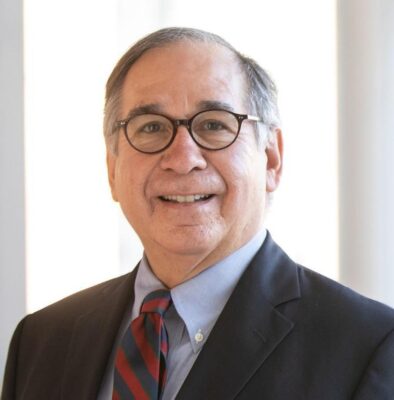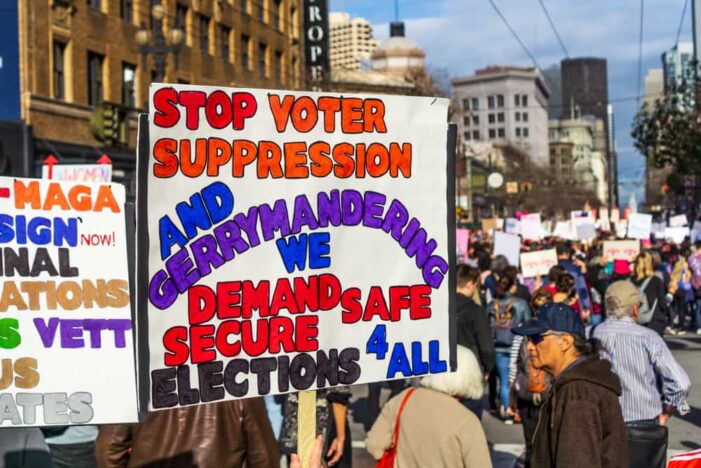Editorial credit: Sundry Photography / Shutterstock.com
By Pearl Phillip
The intricate concepts of redistricting and gerrymandering can uphold and challenge the very essence of democracy, and this election year is a prime example of that as New York deals with its new district lines.
Gerrymandering and redistricting, which occurs every ten years in New York state to coincide with the U.S. census, are crucial concepts in electoral processes. These practices significantly impact representation, as gerrymandering can lead to disproportionate influence for specific parties or groups, reducing the overall competitiveness of elections and potentially disenfranchising voters.
Consequently, while redistricting aims to uphold democratic principles, gerrymandering can subvert them, leading to debates about the integrity and equity of electoral systems.
Recently, on the People, Power & Politics Radio Show and Podcast, I had the privilege of engaging in a thought-provoking conversation with Jeffrey M. Wice, a seasoned expert with over 40 years of experience in redistricting, voting rights, and census law. He is considered a national expert on redistricting and has been included in Roll Call’s list of the top 50 Washington policy insiders.

Wice explained the concept of reapportionment, saying: “That’s a phrase often confused with redistricting, and I’ll get to gerrymandering, too. Reapportionment is the reallocation of the 435 Congressional districts among the 50 states based on the decennial census. It’s a very ministerial process. A federal law formula that merely by algorithm assigns the 435 districts to the 50 states is in place. That’s called reapportionment.”
However, the concept of gerrymandering often raises eyebrows and sparks debates.
Impact of Gerrymandering on Democratic Governance
Gerrymandering, a term tinged with political intrigue, refers to strategically manipulating district lines to favor one political party or candidate over another.
The term “gerrymander” traces back to Massachusetts Governor Elbridge Gerry’s maneuver in 1812 to secure his party’s dominance in the state senate through redistricting. An enterprising newspaper illustrator depicted the most blatant district with a salamander’s head, thus coining the term “gerrymandering” to describe the unfair manipulation of electoral boundaries.
The responsibility for drawing new district lines falls to the state legislature, which has often led to partisan manipulation of boundaries to maintain or strengthen the power of the party in control. This practice can result in oddly shaped districts that carve out areas of political support or dilute the voting power of specific communities.
This practice, Wice emphasized, can undermine the core democratic principle of fair representation, allowing politicians to choose their voters rather than the other way around. By skewing boundaries to entrench the power of a majority party, gerrymandering distorts the very fabric of democracy, casting shadows over the notion of government by the people, for the people. “When politicians draw lines to benefit themselves, that doesn’t help the voters. When you vote, you’re supposed to vote for the candidate you want to win. But if the politicians who draw the lines draw them in a way that, let’s say, creates a super majority of Democrats for the Democratic Party or Republicans for the Republican Party candidates. In that case, it’s really the politicians picking their voters because there’s less competition. There’s much more of a likelihood that the party drawing the lines will control the outcome of the election,” he said.
Communities of color have historically faced systemic barriers to political representation and power. Gerrymandering can compound these challenges by strategically redrawing electoral district lines to weaken the voting strength of concentrated groups of minority voters.
Packing, Cracking, and the Impact on Communities of Color
New York has had its share of gerrymandering controversies, but it’s worth noting that the state has attempted to address this issue through independent redistricting commissions. However, historical examples can still show how gerrymandering has affected minority representation in the state.
Certain districts in New York City, such as parts of Brooklyn and the Bronx, have been criticized for ‘packing’ minority voters. As seen in the 12th Congressional District, previously represented by Carolyn Maloney from 2013 to 2023, this practice concentrates Democratic-leaning minority voters — particularly African American and Hispanic communities — into one district. The aim is to limit their influence in surrounding areas, effectively reducing the overall impact of minority voters on statewide elections and limiting their ability to elect candidates of their choice.
Gerrymandering employs various strategies to dilute the voting power of minority communities. One such strategy is ‘cracking,’ where minority communities are divided among several districts. This was evident in the redistricting following the 2010 Census in Queens and parts of Long Island. Asian American and Hispanic communities were fragmented among several districts, which weakened the collective voting strength of these minority groups and made it more challenging for them to elect representatives who truly reflected their interests.
By packing minority voters into a small number of districts or spreading them thinly across multiple districts, gerrymandering ensures that their voices are not adequately represented.
“When you pack minority voters into, let’s say, one district, You make a district, let’s just say 70, 80, 90% black, that is called packing. It will ensure that you’re going to help the minority community elect its preferred candidate. Still, you are also eliminating the possibility that minority voters can elect more than one elected official in more than one district,” Wice said.
“Now, the opposite of that is called cracking, where you have a concentration at whatever percentage of minority voters who are cracked or split amongst various districts. That makes it then impossible for them to elect a preferred candidate. Now, over the years, the law has changed a bit, but using the Federal Voting Rights Act as an example, if you have a situation where you have a minority community, let’s say, of Black residents, Black voters, voters, and they have not been able to elect their preferred candidate. You have a high level of racially polarized voting, a situation where the white voters consistently outvote the minority voters and deny them the opportunity to elect their preferred candidates, then you have a situation called racially polarized voting,” he added.
According to the October 2023 report, Community Redistricting Report Card released by Common Cause in 2023, communities of color continue to be marginalized and excluded from redistricting. Despite their significant role in driving population growth in many states, these communities are frequently denied representation when redistricting decisions are made.
Politicians entrenched in power perceive these communities as a challenge to their political dominance, making the process inaccessible and manipulating district boundaries to diminish their voting influence. It remains critical for communities of color to organize and advocate for a voice in redistricting, given their historical disenfranchisement and ongoing targeting by political interests. New York got a D grade in the report.
Also Read: How Citizens Can Advocate for Fair Redistricting
Gerrymandering in New York
New York State has the John R. Lewis New York State Voting Rights Act, passed in June 2022. “The Act requires that if you have an area, a community, with a level of highly racially polarized voting, and you have a minority community or adjacent communities of, let’s say, Black and Hispanic voters who have not been able to elect a preferred candidate to office. By office, I mean City Council, State Legislature, and Congress. Then, under the new state law, you can combine and join various disparate minority communities and put them together in one district, regardless of whether you reach 50% or more in population, and create a district,” Wice explained.
He added, “The person who controls the pen drawing the districts can pretty much help determine, for the most part, the outcome of how an election is likely to turn out.” Efforts to address gerrymandering in New York have included calls for independent redistricting commissions to draw district lines rather than leaving the process in the hands of politicians. While not fully implemented, these proposals promise a fairer and more representative political landscape. Wice said the Lewis Act does rectify this somewhat by requiring “that you look at communities that are like-minded that might not reach 50% under federal standards, but under state law, you can create a district that might only have 30% or 40% of minority voters, and not just Black voters, not just Hispanic voters, but of both races and ethnicities.”
In 2014, voters in the state gave the green light to a constitutional amendment establishing what they determined would be an independent redistricting commission. However, the commission’s structure was primarily crafted by former governor Andrew Cuomo and the Republican majority in the state Senate, who aimed to secure their hold on power regardless of electoral outcomes.
“The process imploded. It failed. It wasn’t until the very end that something finally clicked, Wice said. The New York state constitutional amendment had left too many hypothetical situations without legal language to resolve them and too many loopholes to get around the problem the amendment attempted to solve. Wice suggested a new amendment that is more reflective of voters’ wants in 2024 and beyond.
“Fixing problems like having an odd member to break a tie in a commission to rank in priority order the criteria that the commission ought to use to change the requirements on how the commission and the legislature can approve a map, not based on who controls the legislature, but allow simple majority votes to determine the outcome of maps and other decisions commissions have to make, not get tied up in log jams that result in implosion,” are possible solutions to be included in a new amendment according to Wice.
The other possible solution is to inform people—specifically voters—about the importance of the next census, scheduled for 2030. The impact on voting districts and the fact that the census collects socioeconomic data to determine how government programs are funded will be crucial points to teach New York residents, particularly in Black, Brown, immigrant, and low-income communities all over the city, specifically Kings County,” Wice explained.
In the meantime, the intricate dance of redistricting, gerrymandering, and democracy continues to shape the political landscape. By shedding light on these nuanced processes and their implications, we can strive toward a more equitable and representative electoral system.
This story was produced as part of the 2024 Elections Reporting Mentorship, organized by the Center for Community Media and funded by the NYC Mayor’s Office of Media and Entertainment.

